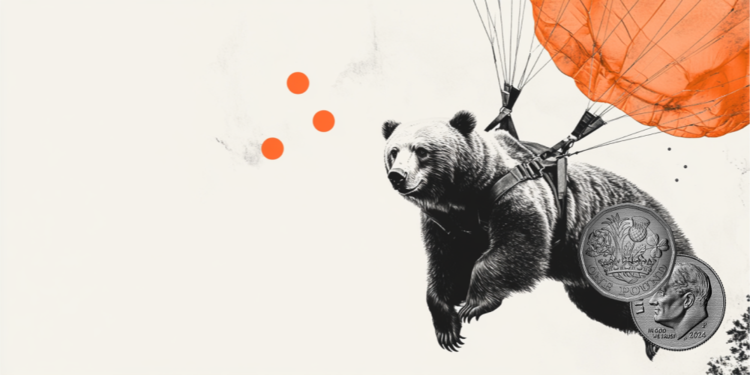Higher temperatures in the Arctic are thawing the region’s permafrost – a frozen layer of soil below the ground – and potentially activating viruses that, after lying dormant for tens of thousands of years, could endanger animal and human health.
While a pandemic triggered by a disease from the distant past sounds like the plot of a science fiction movie, scientists warn that the risks, while low, are underestimated. Chemical and radioactive waste dating back to the Cold War, which has the potential to harm wildlife and disrupt ecosystems, can also be released during the thaw.
“There’s a lot going on with permafrost that is concerning and really shows why it’s super important that we keep as much permafrost frozen as possible,” said Kimberley Miner, a climate scientist at NASA’s Jet Propulsion Laboratory at the California Institute of Technology. in Pasadena, California.
Permafrost covers a fifth of the Northern Hemisphere, having supported the Arctic tundra and boreal forests of Alaska, Canada and Russia for millennia.
It serves as a kind of time capsule, preserving – in addition to ancient viruses – the mummified remains of several extinct animals that scientists have managed to unearth and study in recent years, including two cave lion cubs and a woolly rhino.
The reason permafrost is a good storage medium isn’t just because it’s cold; it is an oxygen-free environment that light cannot penetrate. But current Arctic temperatures are warming up to four times faster than the rest of the planet, weakening the top layer of permafrost in the region.
To better understand the risks posed by frozen viruses, Jean-Michel Claverie, professor emeritus of medicine and genomics at the Aix-Marseille University School of Medicine in Marseille, France, tested soil samples taken from Siberian permafrost to see if any viral particles contained in it are still infectious.
He’s been on the hunt for what he describes as a “zombie virus” – and he’s found quite a few.

the virus hunter
Claverie studies a specific type of virus that he first discovered in 2003. Known as giant viruses, they are much larger than the typical variety and visible under an ordinary light microscope rather than a more powerful electron microscope – which makes a good model for it.
Their efforts to detect viruses frozen in permafrost were partly inspired by a team of Russian scientists who in 2012 revived a wildflower from 30,000-year-old seed tissue found in a squirrel’s burrow. Since then, scientists have also brought ancient microscopic animals back to life.
In 2014, he managed to revive a virus he and his team isolated from permafrost, making it infectious for the first time in 30,000 years, by inserting it into cultured cells. To be on the safe side, he chose to study a virus that could only target single-celled amoebae, not animals or humans.
He repeated the feat in 2015, isolating a different type of virus that also targeted amoebas. And in their most recent research, published Feb. 18 in the journal Viruses, Claverie and his team isolated several ancient virus strains from various permafrost samples taken from seven different places in Siberia and showed that each of them could infect cultured amoeba cells. .

These latest strains represent five new virus families, in addition to the two he had previously revived. The oldest was nearly 48,500 years old, based on radiocarbon dating of the soil, and came from a soil sample taken from an underground lake 16 meters below the surface.
The youngest samples, found in the stomach contents and fur of the remains of a woolly mammoth, were 27,000 years old.
The fact that viruses that infect amoebas are still infectious after so long is indicative of a potentially larger problem, Claverie said. He worries that people will consider his research a scientific curiosity and not perceive the possibility of ancient viruses coming back to life as a serious threat to public health.
“We see these amoeba-infecting viruses as stand-ins for all the other possible viruses that could be in permafrost,” Claverie told CNN .
“We see traces of many, many, many other viruses,” he added. “So we know they are there. We don’t know for sure if they are still alive. But our reasoning is that if the amoeba viruses are still alive, there’s no reason why other viruses can’t stay alive and be able to infect their own hosts.”
Precedent for human infection
Traces of viruses and bacteria that can infect humans have been found preserved in permafrost.
A lung sample from the body of a woman exhumed in 1997 from permafrost in a village on the Seward Peninsula, Alaska, contained genomic material from the influenza strain responsible for the 1918 pandemic.
In 2012, scientists confirmed that the 300-year-old mummified remains of a woman buried in Siberia contained the genetic signatures of the virus that causes smallpox.
An anthrax outbreak in Siberia, which affected dozens of humans and more than 2,000 reindeer between July and August 2016, has also been linked to deeper permafrost thaws during exceptionally hot summers, allowing old Bacillus anthracis spores to re-emerge from old cemeteries or animal carcasses.
Birgitta Evengård, emeritus professor at the Department of Clinical Microbiology at Umea University in Sweden, said there should be better surveillance of the risk posed by potential pathogens in permafrost thaw, but warned against an alarmist approach.
“You have to remember that our immune defense was developed in close contact with the microbiological environment,” said Evengård, who is part of the CLINF Nordic Center of Excellence, a group that investigates the effects of climate change on the prevalence of infectious diseases in humans and animals in the northern regions.
“If there is a virus hidden in the permafrost that we haven’t had contact with for thousands of years, it could be that our immune defense is not enough,” she said. “The right thing is to have respect for the situation and be proactive and not just reactive. And the way to fight fear is to have knowledge.”

Chances of viral spread
Of course, in the real world, scientists don’t know how long these viruses can remain infectious once exposed to current conditions, or how likely the virus is to find a suitable host.
Not all viruses are pathogens that can cause disease; some are benign or even beneficial to their hosts. And although it is home to 3.6 million people, the Arctic is still a sparsely populated place, making the risk of human exposure to ancient viruses very low.
Still, “the risk tends to increase in the context of global warming,” said Claverie, “in which permafrost thaw will continue to accelerate and more people will populate the Arctic as a result of industrial developments.”
And Claverie is not alone in warning that the region could become a breeding ground for a spillover event – when a virus jumps to a new host and begins to spread.
Last year, a team of scientists published research on soil and lake sediment samples taken from Lake Hazen, a freshwater lake in Canada located in the Arctic Circle. They sequenced the genetic material in the sediment to identify viral signatures and the genomes of potential hosts – plants and animals – in the area.
Using a computer model analysis, they suggested that the risk of viruses spreading to new hosts was greater in locations close to where large amounts of glacial meltwater flowed into the lake – a scenario that becomes more likely as climate changes. heats up.

unknown consequences
Identifying viruses and other hazards contained in warming permafrost is the first step in understanding the risk they pose to the Arctic, said Miner of NASA’s Jet Propulsion Laboratory. Other challenges include quantifying where, when, how quickly and how deeply permafrost will thaw.
Melting can be a gradual process of just a few centimeters per decade, but it also happens more quickly, as in the case of large land depressions that can suddenly expose deep, ancient layers of permafrost.
The process also releases methane and carbon dioxide into the atmosphere – an overlooked and underestimated driver of climate change.

Miner cataloged a number of potential hazards currently frozen in Arctic permafrost in a 2021 paper published in the scientific journal Nature Climate Change.
These potential dangers included buried waste from heavy metal mining and chemicals such as the pesticide DDT, which was banned in the early 2000s. Radioactive material has also been dumped into the Arctic – by Russia and the United States – since the advent of the nuclear tests in the 1950s.
“Abrupt thaw rapidly exposes old permafrost horizons, releasing compounds and microorganisms sequestered in deeper layers,” Miner and other researchers noted in the 2021 paper. .
In the research paper, Miner labeled direct infection of humans with ancient pathogens released from permafrost as “currently unlikely.”
However, Miner said she is concerned about what she called “Methuselah microorganisms” (named after the biblical figure with the longest lifespan). These are organisms that could bring the dynamics of ancient and extinct ecosystems into the Arctic today, with unknown consequences.
The resurgence of ancient microorganisms has the potential to alter soil composition and vegetative growth, possibly further accelerating the effects of climate change, Miner said.
“We’re not sure how these microbes are going to interact with the modern environment,” she said. “It’s not really an experiment that I think any of us would want to do.”
The best course of action, Miner said, is to try to stop the thaw and the broader climate crisis, and keep those dangers buried in the permafrost forever.
Source: CNN Brasil
Bruce Belcher is a seasoned author with over 5 years of experience in world news. He writes for online news websites and provides in-depth analysis on the world stock market. Bruce is known for his insightful perspectives and commitment to keeping the public informed.







